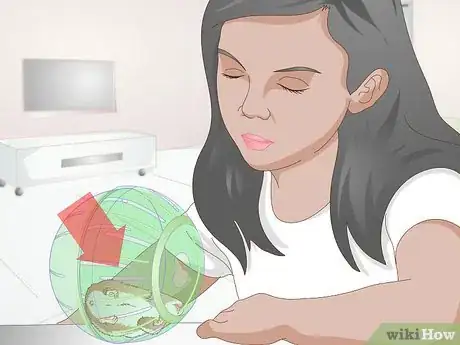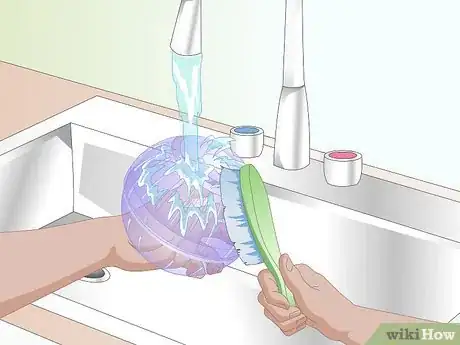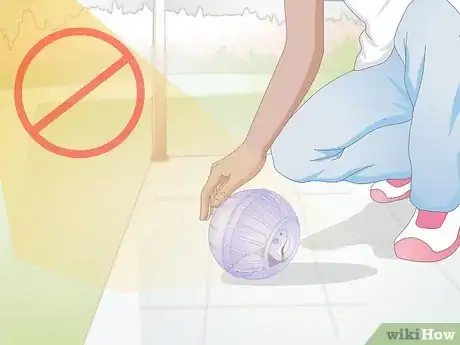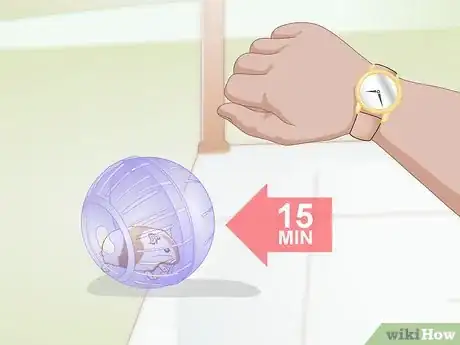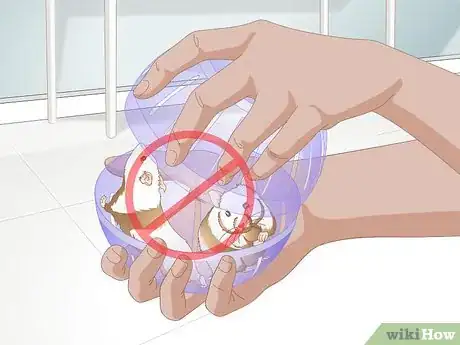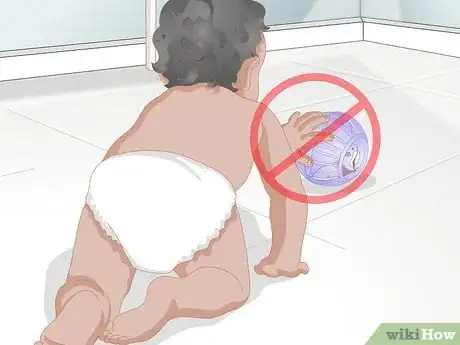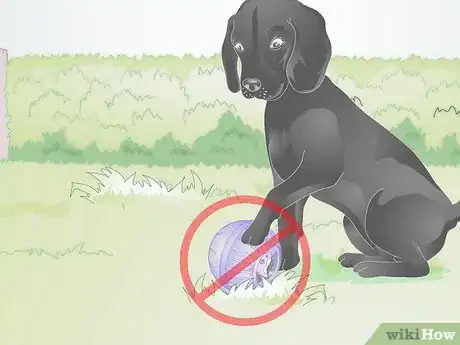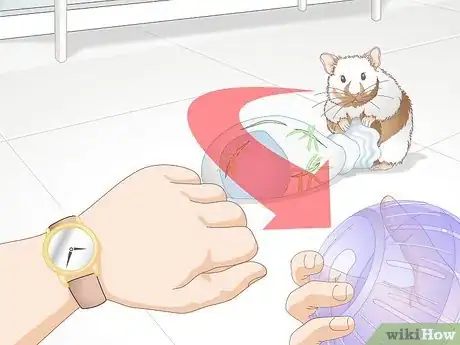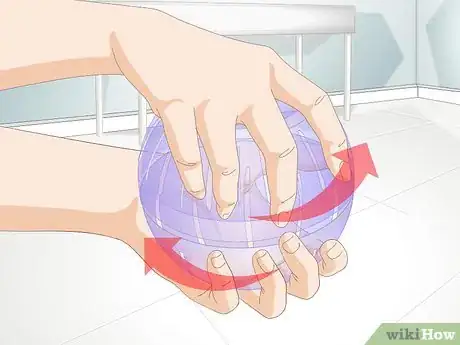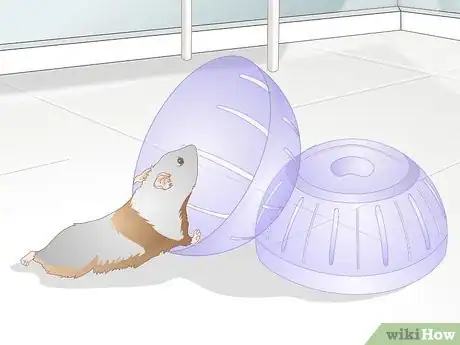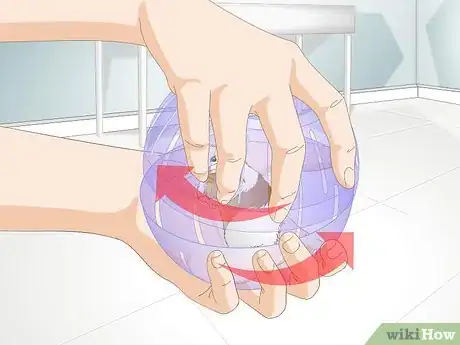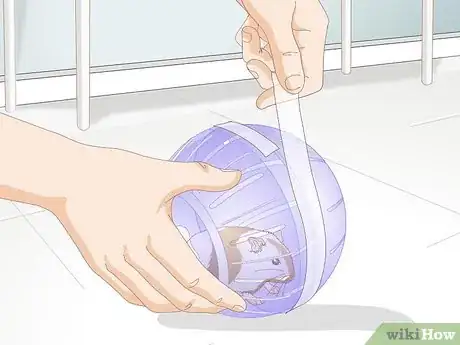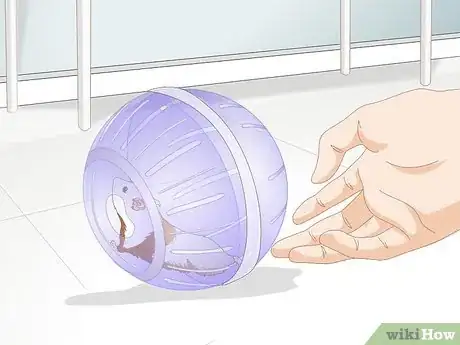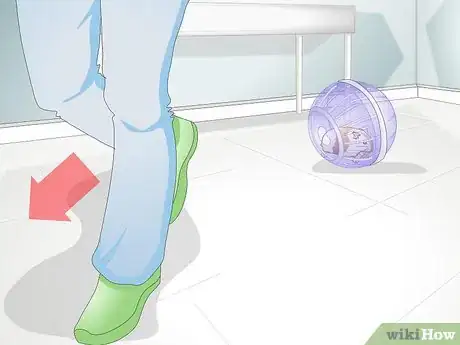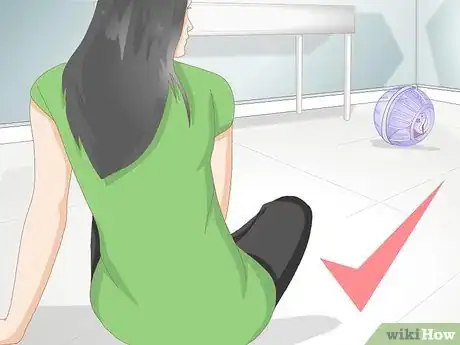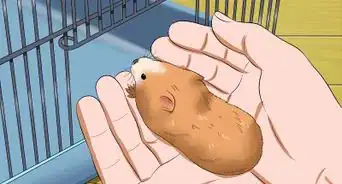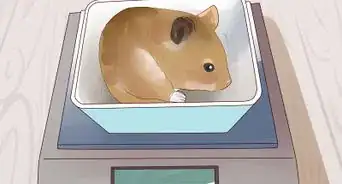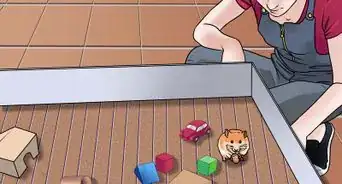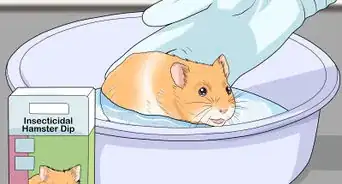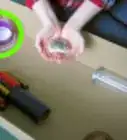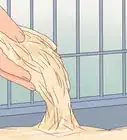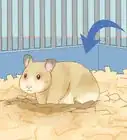This article was co-authored by Pippa Elliott, MRCVS. Dr. Elliott, BVMS, MRCVS is a veterinarian with over 30 years of experience in veterinary surgery and companion animal practice. She graduated from the University of Glasgow in 1987 with a degree in veterinary medicine and surgery. She has worked at the same animal clinic in her hometown for over 20 years.
This article has been viewed 53,214 times.
Owning a hamster is a great way to enjoy the benefits of pet ownership. Not only are hamsters cute, but they’re quite entertaining and really fun if you provide them with everything they need. The key to having a great experience as a hamster owner, is to treat your hamster appropriately and to make sure they are happy, healthy, and entertained. One of the best ways to make sure they are happy, healthy, and entertained is to buy a hamster ball. Hamster balls are a great way to get your hamster to exercise. At the same time, they’ll also provide you with some entertainment. But, remember, pets are not toys. They are living creatures that feel pain and discomfort. Use your hamster ball with care and treat your hamster with the respect he or she deserves as a living being!
Steps
Avoiding Potential Problems
-
1Learn about the risks of hamster balls. While hamster balls are extremely popular, many people are critical of hamster balls because of the potential risks they pose to our small furry hamster friends. Before buying a hamster ball, you need to learn about and consider the numerous risks these popular toys can pose to your friend.
- Hamster balls can create unneeded stress and anxiety for your furry friend.
- If not used right, hamster balls can present physical dangers to your small friend.
- Many veterinarians and animal rights activists have criticized hamster balls.[1]
-
2Choose your hamster ball. Choosing your hamster ball will depend on several factors. Before you even buy the ball, there are important things you need to consider so that your little friend will enjoy his/her exercise machine. Consider:
- Make sure the hamster ball is big enough for your little friend. There are a number of varieties of hamsters (most popularly, dwarf and Syrian), so make sure that whatever ball you’ll be buying will be big enough for your hamster when he or she reaches maturity.
- Choose a color. Hamster balls come in a wide variety of different colors. Try to avoid dark colors, so that you’ll be able to see your hamster clearly at all times.
- Make sure your hamster ball has plenty of holes in it for ventilation. While most commercially produced hamster balls do have plenty of ventilation, you should still be cognizant of this when purchasing your ball.
- Avoid using “homemade” or “custom” hamster balls unless the builder/designer has a lot of experience. Homemade balls might be dangerous – they could open up unexpectedly or lack enough ventilation for your furry friend.
Advertisement -
3Clean your hamster ball after purchasing it. Before you even put your little friend into the ball, you should open it up and clean it. Many times, plastic animal toys come from the factory without being properly cleaned from potentially toxic and dangerous residues and films.
-
4Limit your hamster’s exposure to sunlight while in the hamster ball. Because of the nature of the hamster ball (a translucent piece of plastic), hamster balls tend to magnify light and trap heat inside. If you allow your hamster to play in his ball outside, you might be creating an extremely dangerous situation for your friend.
- Hamsters are sensitive to sunlight.
- Hamsters who play in their ball in the sunlight might tend to overheat or dehydrate.
- Limit your hamsters to indoors or at the very least to extremely overcast (but not freezing) days outside.
-
5Limit the amount of time your hamster is in his or her ball. Even though playing in a ball might seem like a lot of fun for your hamster, your little friend can also get worn out, tired, and dehydrated real quickly. Make sure to monitor his or her time in the ball.
- Take your hamster out when he or she is tired.
- Begin with no more than 15 minutes.
- If your hamster seems to handle it well, after 3 or 4 times, you can gradually increase the amount of time your hamster plays in the ball. Just make sure to monitor and use your best care and judgement.
- If your hamster seems lethargic after playing in the ball, and does not recover quickly, consult your veterinarian.[2]
-
6Do not put more than one hamster in a ball. Hamster balls are relatively confined spaces. As a result, never put more than one hamster in a ball at one time. The balls are designed for one hamster, and one hamster alone. There are numerous dangers to putting more than one animal in a ball at a time:
- The hamsters could get into a fight.
- One hamster might not be as fit as the other, and could be thrown around as his or her friend is moving the ball.
- The hamsters could become extremely stressed or anxious because of the confined space.
-
7Never let a small child play with a hamster while in a hamster ball. Small children often do not understand that animals are autonomous lifeforms that feel pain and are fragile. As a result, never let a small child play with a hamster while the hamster is in a ball. At the same time, never let a small child play with any animal unattended. This will help safeguard the life of the animal and the welfare of the child.[3]
-
8Avoid letting your hamster play in his or her ball in an area where other pets are loose. Letting other animals play around a hamster is creating a dangerous situation for the hamster. As small domesticated animals, hamsters are vulnerable and fragile animals. When your hamster is in his or her ball playing, do not let other animals play in the same area.
- Close off any area that your hamster is playing in.
- Dogs or cats might see your hamster as a toy and try to rip its stuffing out.
- Larger pets might be confused and might not understand what the hamster and his or her ball is doing.
- If you do have two hamsters in two separate balls, it is okay to let them play in the same area. Just make sure to monitor them so they don’t run into each other or hurt themselves.[4]
-
9Cleaning your hamster ball. Caring for and cleaning a hamster ball is much like caring for and cleaning a hamster’s cage. You need to clean the ball regularly as to prevent bacteria and other waste from building up and possibly harming your little furry friend.
- Clean the hamster ball after every use, if possible.
- Clean the hamster ball at least every couple of uses, no matter what.
- Clean the hamster ball immediately if your hamster has had an accident in it.[5]
Letting Your Hamster Play in the Ball
-
1Pick a play time. Perhaps the most challenging part of getting your hamster to use his or her ball is finding a time that they actually want to use it. You’ve got to time this properly, because if your hamster is tired or just not in the mood, they’re not going to do anything, and they’ll just sit there. Consider:
- Choosing a time when your hamster is active.
- Don’t choose a time directly before or directly after feeding.
- Once you’ve used the ball a few times, it should be easier to figure out when your hamster wants to play in his or her ball.
-
2Untwist the ball open. Hamster balls often have two designs to open them. Either way, you’ll have to twist the ball or the entrance open in order to let your hamster in. Make sure to do this gently, as you don’t want to damage your ball.
- Some hamster balls are separated into two sides, and you’ll twist one side off the other to open it.
- Some hamster balls have a small circular opening on one side of the sphere. You’ll have to twist the door of the ball open to let your hamster in.
- If your hamster ball is designed differently, consult your instructions.
-
3Allow your hamster to enter the ball. Best practice is to open the ball and allow your hamster to enter on their own accord. You don’t want to throw your hamster in there and traumatize him or her for no reason. If your hamster does not want to go in, try again later.
- Open the ball and direct your hamster toward the opening. You can guide him or her, but don’t throw them in against their own will.
- Try putting a treat in to lure your hamster in. If your hamster goes for the treat, slowly close the ball and allow your hamster to eat the treat before anything else.
- If your hamster is still reluctant, place the ball inside his or her cage to allow him or her to get used to the ball. Just make sure to watch them, as they might hurt themselves playing in a ball that is not secured.[6]
-
4Twist the top back on. Once your hamster has boarded the ball on their own accord, twist the ball shut and make sure it clicks and is secure so your hamster cannot escape. This is extremely important, as you don’t want the ball to open while your hamster is running around.
-
5Apply packing or scotch tape as an extra measure to keep the ball shut. After you’ve loaded your furry friend into his or her ball, apply a little tape to two sides in order to provide an extra layer of protection against the ball opening. This will serve a dual purpose of keeping your hamster safe and making sure he or she does not escape into the wilds of your home.
- Apply the tape smoothly to the crack that separates the two sides of the sphere (or on the entrance to the ball).
- Make sure that the pieces of tape are not available inside of the sphere. You don’t want your little friend chewing on or swallowing the tape.
- Make sure your ball is dry when applying tape.[7]
-
6Put the ball on a flat surface, if it is not already. Once your hamster has boarded, the ball is secure, and taped, then move the ball to a flat surface where your hamster will safely be able to move around. Carpet is best for this and will limit the vibrations and other stresses to the ball and to the hamster.[8]
-
7Leave them alone while they are in the ball. If they stop, do not force them to roll. It either means they are sniffing their surroundings or just tired. If they stop rolling for at least 7 minutes, it means they are probably tired and let them back in their cage. If they get stuck in a corner do not pick them up and move them because they are probably just resting. They can get out on their own.[9]
-
8Monitor your hamster at all times. One mistake people often make with hamster balls is to let their hamster roam around freely in their ball. This could have potentially devastating and certainly dangerous results. In order to prevent your little friend from getting hurt, you need to monitor your hamster at all times when he or she is in a hamster ball. Consider:
- Sitting on the floor with your hamster when he or she is in the ball.
- Closing off an area, like a living room or bedroom so that your hamster won’t be able to leave your site.
- Make sure that your hamster won’t be able to access any stairs or similar hazards while in his or her ball.
- Never let your hamster roam around unattended – in or out of a ball.
Warnings
- Do not let them roll in a room with lots of furniture, as they can crash a lot.⧼thumbs_response⧽
- Never leave your hamster in a ball for more than 20 minutes without food or water.⧼thumbs_response⧽
- Don't let it by anything that runs on electricity or gas. They could break a cable or line and get a big shock or could drink some kind of gas and die!⧼thumbs_response⧽
- Do not leave your hamster on a second story unattended. Preferably you should be in a room with the door closed. Your hamster could roll and bounce down the stairs, which could hurt him/her.⧼thumbs_response⧽
References
- ↑ http://how-to-care-for-hamsters.tumblr.com/post/110089150095/why-hamster-balls-are-very-dangerous-and-should
- ↑ http://www.smallanimalchannel.com/hamsters/hamster-interaction/hamster-ball-tips.aspx
- ↑ http://www.caringpets.org/how-to-take-care-of-a-hamster/accessories/
- ↑ http://www.smallanimalchannel.com/hamsters/hamster-interaction/hamster-ball-tips.aspx
- ↑ http://www.smallanimalchannel.com/hamsters/hamster-interaction/hamster-ball-tips.aspx
- ↑ http://hamsterhideout.com/forum/topic/52245-exercise-ball-okay/
- ↑ http://www.smallanimalchannel.com/hamsters/hamster-interaction/hamster-ball-tips.aspx
- ↑ http://www.smallanimalchannel.com/hamsters/hamster-interaction/hamster-ball-tips.aspx
- ↑ http://www.caringpets.org/how-to-take-care-of-a-hamster/accessories/
About This Article
To use a hamster ball, choose a ball that's big enough for your pet and that has plenty of holes so it can breathe and stay cool. Limit your hamster's time in the ball to 15 minutes to start and never leave it unsupervised while it's inside. Then, when your pet is inside the hamster ball, keep it safe by avoiding stairs, other pets, and intense sunlight. Never put more than 1 hamster inside of a ball, either. For more tips from our Veterinary reviewer on how to use a hamster ball the right way, like how to clean the ball, keep reading.
